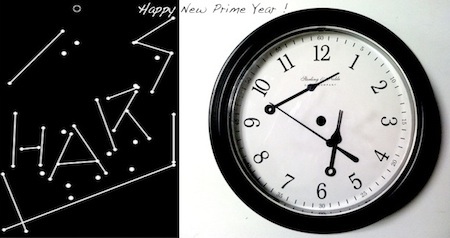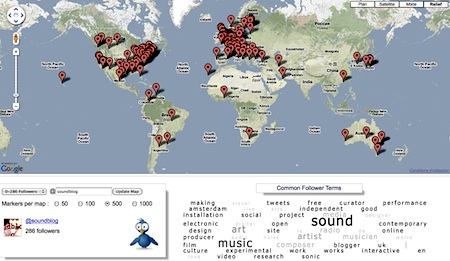Happy New Prime Year!
[ SB Tweet Digest #10
(nov/dec 2010) ]
january 01, 2011.
...
[ On Kawara | Cage | Google Translates Beatbox | Beating Marcel Duchamp ]
![]() November and December 2010 together saw _104_ + _97_ =
_201_ SoundBlog
tweets (including some, but not all, re-tweets). Here's a selection
to wrap up 2010, along with some comments and elaborations. Let me also
remind you of 'The SoundBlog Tweets
Daily', a weekly digest Swiss auto-made @SmallRivers
(of which, by the way, also the older editions remain available).
November and December 2010 together saw _104_ + _97_ =
_201_ SoundBlog
tweets (including some, but not all, re-tweets). Here's a selection
to wrap up 2010, along with some comments and elaborations. Let me also
remind you of 'The SoundBlog Tweets
Daily', a weekly digest Swiss auto-made @SmallRivers
(of which, by the way, also the older editions remain available).
Google Translates Beatbox
- Nov
29, [9317639285374976]
Go *hear* Google german-german translatie "pv zk pv pv zk pv zk kz zk
pv pv zk pv zk zk pzk pzk pvzkpkzvpvzk kkkkk bsch" > http://j.mp/pvZzk
[[Oude Pijp, Amsterdam]]
The Google Translate Beatbox was a most amusing meme, that late November spread like wildfire: if one entered letter combinations like the one in the above tweet into Google Translate, asked for the translation of such phrases from German into German, and then used the 'Listen' button to have the software pronounce the result ... it sounded like 'beatboxing'...
Though the original claims suggested that this was caused by some 'freaky twist' in the Google speech synthesis software, it is far more likely that it rather is another fine Google Easter Egg. A 'hi-tech in-joke', very consciously put in place.
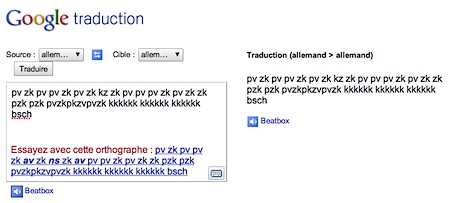
After a while, as you can see in the image, Google actually replaced the 'Listen' button with a 'Beatbox' button. It appears as soon as a combination of signs is entered into the field that is, say, 'beatbox ready'. Also, if you enter a real German word into the 'beatbox' sequence, the beatboxing suddenly no longer occurs, but the voice simply spells out the letters...
Interesting enough, though, to document for posterity. So I decided to use Google Translate to put together a fine Happy New Sound Year wish for all of you SoundBlog viewers. For this I looked up, on the morning of January 1st, from where the last 100 SoundBlog visitors had come. The last visitor at that point was American, so I wrote my New Years wish in English:
"All of us here at the SoundBlog wish you a happy sounding new prime year!"
I then started a chain translation of this phrase in Google Translate. First into French, then French into German and so on and so further, accommodating the languages corresponding to the whereabouts of the SB-visitors. The chain ended with a Russian translation, that I then Google translated back into English:
"Audioblog you all a happy new year to you my first ring!"
Well, we all know how this procedure 'injures' the phrases, but it had never before occurred to me to use this together with the 'speech option': therefore, for the SB's new year wish - which is this SB-edition's (the 44th) podcast - I recorded the Google voices speaking the successive translations, and combined these with - indeed - some of Google's beatboxing sequences. At the end I then 'break' the beatbox, by adding the words 'Böse Katze' to the letter sequence. Suddenly, as if by magic, the German Google voice no longer beatboxes, but just spells out the letters...
The beat-y midi 'popcorn' music that completes the track was edited from a recording (also done on the morning of January 1st) of a random walk over many Isles of Tunes [15668372616253440], a web sound game which sort of came as a fulfillment of my sudden longing to play Gameboy Pokémon [15664959484592128], just for the sound of it... Enjoy!
- Nov
03, [29552205118]
"Dead Drops": @agoasi embeds usb
drives into walls, buildings & curbs for public file-sharing > [ http://j.mp/dddrop
] (via Renewable Music)
[[Vincennes, Paris]] - Nov 03, [29563733593]
[ http://thesoundcollectorsclub.wordpress.com/
] @TheSCClub collects ... sounds (via @timprebble)
[[Estrées-Deniécourt, France]] - Nov 04, [29648646823]
"For me, free improvisation is performing directly in this 3rd dimensional
mode" Mari Kimura on improvisation > [ http://j.mp/impr3rd
]
[[Oude Pijp, Amsterdam]] - Nov 05, [448117971361792]
Curious Ornette Coleman phone interview @laist:
on notes, keys, scales, dominants, the human race & the value of life
http://j.mp/ocintlaist
[[Oude Pijp, Amsterdam]]
How I Managed To Beat Marcel Duchamp At His Own Game
- Dec 01, [9872021802450944]
"... all artists are not chess players, but all chess players are artists"
Try beat Marcel Duchamp at chess (turbulence) http://j.mp/eofKJv
[[Oude Pijp, Amsterdam]]
Scott Kildall,
a cross-disciplinary artist much like myself, won one of last years turbulence.org
commissions, for his project Playing
Duchamp: an algorithm mimicking the game of Marcel Duchamp, the chess master.
After fundamentally having changed the ways, looks and course of Western
art, Marcel
Duchamp gave up producing works of art in favor of playing chess. Scott
abstracted various principles regarding Duchamp's chess strategies, analyzing "72
recorded tournament games played by Marcel Duchamp in the 1920s and 1930s
alongside conversations with Jennifer Shahade, a chess and Duchamp expert".
According to these findings, he modified the GNU Chess code in order to
design a computer algorithm that plays chess like Marcel Duchamp...
The program is up and running at the turbulence web site, where you can register and play chess against 'Marcel Duchamp'.
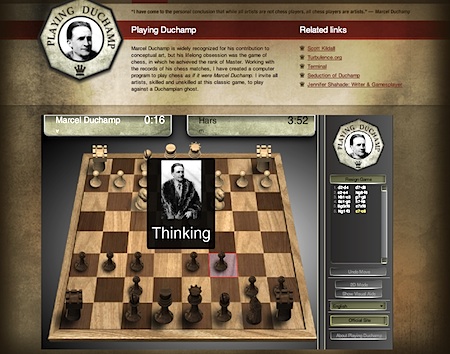
Now isn't that wonderful?
I am not much of chess player myself, though
as a youngster I did go through a period of moderate chess obsession,
studying openings and end games and the like, devouring my fathers pretty
complete collection of Prisma
Schaakboeken.
But all that is long ago, and it indeed is a very long time ago that I last played a serious game of chess.
Still, I decided that I really needed to beat Duchamp at his own game, one way or another... So here is what I did: I opened two different Playing Duchamp accounts at the turbulence web site. Then I launched two different browsers, and started two chess games with Duchamp, one for each of the accounts. I made sure that Duchamp would be playing white in the one, and black in the other. I then applied what in logic and game-theory is known as the copycat strategy: Duchamp opens with white in game A. I open in game B with Duchamp's opening move. Duchamp replies in game B with black. And then I reply with Duchamp's black move in game A. And so on ... Hence, effectively, Duchamp is playing against ... Duchamp :-)
The first two games that I thus had the Duchamp algorithm play against itself ended in a draw:
1. d2-d4 d7-d5 2. c2-c4 d5xc4 3. Ng1-f3 Ng8-f6 4. Nb1-c3 Bc8-f5 5. e2-e3 e7-e6 6. Bf1xc4 Bf8-b4 7. O-O Ke8-g8 8. Qd1-b3 Nb8-c6 9. Bc1-d2 Qd8-e7 10. Bc4-b5 Nc6-a5 11. Qb3-d1 a7-a6 12. Bb5-e2 Na5-c6 13. Qd1-b3 Rf8-d8 14. a2-a3 Bb4xc3 15. Bd2xc3 Bf5-e4 16. Rf1-c1 Be4-d5 17. Qb3-c2 Bd5-e4 18. Qc2-b3 Be4-d5 19. Qb3-c2 Bd5-e4 20. Qc2-b3 Be4-d5 __DRAW ___
1. Ng1-f3 Ng8-f6 2. c2-c4 Nb8-c6 3. d2-d4 e7-e6 4. Nb1-c3 Bf8-b4 5. Bc1-g5 d7-d5 6. Nf3-e5 Bc8-d7 7. c4xd5 e6xd5 8. e2-e3 Bd7-f5 9. Bf1-d3 Bb4xc3 10. b2xc3 Bf5xd3 11. Qd1xd3 Qd8-d6 12. Ne5xc6 b7xc6 13. Bg5-f4 Qd6-e7 14. Qd3-a6 Ke8-g8 15. Qa6xc6 Qe7-e6 16. Qc6xc7 Qe6-a6 17. Qc7-d6 Qa6-d3 18. Qd6-a3 Nf6-e4 19. Ra1-d1 Qd3-c2 20. O-O Ne4xc3 21. Rd1-e1 Nc3xa2 22. Re1-a1 Na2-c3 23. Kg1-h1 Nc3-e2 24. Bf4-e5 f7-f6 25. Be5-d6 Rf8-c8 26. Rf1-e1 Ne2-c3 27. Re1-c1 Qc2-d3 28. Qa3-b3 Qd3-c4 29. Qb3-b7 a7-a5 30. Qb7-d7 Qc4-b5 31. Qd7-f5 Qb5-e8 32. Bd6-c5 Qe8-e4 33. Qf5-h3 Nc3-e2 34. Rc1-e1 Ne2-c3 35. f2-f3 Qe4-g6 36. e3-e4 Qg6-f7 37. Ra1-a3 Nc3-b5 38. Ra3xa5 Rc8-b8 39. Ra5xa8 Rb8xa8 40. Qh3-f5 Ra8-e8 41. Re1-b1 Nb5-c3 42. Rb1-c1 g7-g6 43. Qf5-h3 Qf7-b7 44. Qh3-h6 Nc3-a4 45. Qh6-d2 Na4xc5 46. d4xc5 d5xe4 47. c5-c6 e4-e3 48. Qd2xe3 Qb7xc6 49. Rc1xc6 Re8xe3 50. Kh1-g1 Kg8-f7 51. Kg1-f2 Re3-e7 52. Kf2-g3 g6-g5 53. Rc6-d6 Kf7-g6 54. Rd6-d5 h7-h5 55. Kg3-f2 Re7-e5 56. Rd5xe5 f6xe5 57. Kf2-g3 Kg6-f5 58. h2-h4 g5xh4 59. Kg3xh4 Kf5-g6 60. Kh4-h3 Kg6-f6 61. Kh3-h4 Kf6-g6 62. Kh4-h3 Kg6-f6 63. Kh3-h4 Kf6-g6 64. Kh4-h3 Kg6-f6 65. Kh3-h4 __DRAW__
But the third one was a win for black...
1. d2-d4 Ng8-f6 2. c2-c4 e7-e6 3. Nb1-c3 Bf8-b4 4. Bc1-g5 d7-d5 5. c4xd5 e6xd5 6. e2-e3 Ke8-g8 7. Ng1-f3 Qd8-d6 8. Bf1-d3 Bb4xc3 9. b2xc3 Bc8-g4 10. O-O Nb8-d7 11. Bg5-f4 Qd6-c6 12. Ra1-b1 a7-a6 13. Rb1-c1 b7-b5 14. Bd3-e2 Nf6-e4 15. Nf3-g5 Bg4xe2 16. Qd1xe2 Rf8-e8 17. Ng5xe4 Re8xe4 18. Qe2-g4 Re4-e6 19. Bf4-g3 Ra8-e8 20. Qg4-f4 Re8-c8 21. Rf1-d1 Re6-f6 22. Qf4-g5 Rc8-e8 23. Bg3-f4 a6-a5 24. Rc1-b1 Rf6-g6 25. Qg5-f5 Nd7-b6 26. Rb1-b3 Nb6-c4 27. Bf4-g3 a5-a4 28. Rb3-b4 Rg6-f6 29. Qf5-b1 Rf6-e6 30. Rd1-e1 Qc6-d7 31. Bg3-f4 Re6-f6 32. Re1-d1 Rf6-b6 33. Rd1-e1 Qd7-c6 34. Qb1-f5 Re8-e6 35. Qf5-g5 Rb6-b8 36. e3-e4 Rb8-e8 37. Rb4-b1 f7-f6 38. Qg5-g3 Re8-e7 39. f2-f3 d5xe4 40. f3xe4 Re6xe4 41. Re1xe4 Re7xe4 42. Rb1-f1 Qc6-e6 43. Bf4xc7 Nc4-d2 44. Rf1-a1 Re4-e3 45. Qg3-f2 Qe6-e4 46. Ra1-d1 b5-b4 47. Bc7-a5 b4-b3 48. a2xb3 a4xb3 49. c3-c4 Nd2xc4 50. Ba5-b4 Re3-e2 51. Qf2-g3 Re2xg2 52. Qg3xg2 Qe4xg2 53. Kg1xg2 Nc4-e3 54. Kg2-f3 Ne3xd1 55. Bb4-a3 b3-b2 56. Ba3xb2 Nd1xb2 57. Kf3-e4 Kg8-f7 58. d4-d5 Kf7-e7 59. Ke4-d4 Ke7-d6 60. h2-h4 Nb2-a4 61. h4-h5 f6-f5 62. Kd4-e3 g7-g5 63. h5xg6 h7xg6 64. Ke3-f4 Kd6xd5 65. Kf4-g5 Kd5-e5 66. Kg5-h4 Na4-c3 67. Kh4-g3 g6-g5 68. Kg3-g2 g5-g4 69. Kg2-f2 Nc3-e4 70. Kf2-f1 f5-f4 71. Kf1-e2 f4-f3 72. Ke2-e3 Ke5-d5 73. Ke3-d3 g4-g3 74. Kd3-e3 g3-g2 75. Ke3-d3 g2-g1=Q 76. Kd3-c2 Qg1-a1 77. Kc2-b3 Qa1-b1 78. Kb3-a4 Kd5-c4 79. Ka4-a5 Qb1-b5 __MATE__
Which then allowed me to make the screenshot that all along had been the goal of this particular exercise: Check and mate! Jan Harsman beats Marcel Duchamp at his own game ... :-)
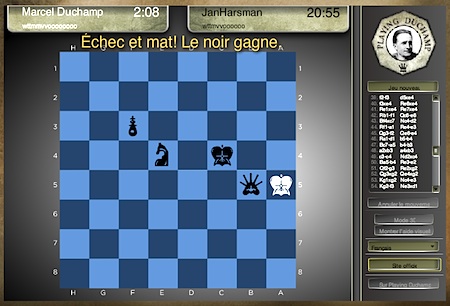
- Nov 05, [453506410487808]
Desperately seeking @stedelijk
(male) readers for On Kawara's One Million Years > [ http://bit.ly/drZ4oE
(Dutch) ] (via @trendbeheer)
[[Oude Pijp, Amsterdam]]
I find it strange that the Temporary Stedelijk in Amsterdam has such a hard time finding volunteers to read On Kawara's 'one million years'. My earlier reading, almost six years ago at De Appel, was an interesting enough experience to repeat. Ever since the Temporary Stedelijk opened end of August last year, I had wanted to go and do an On Kawara reading and get my free entrance to the show. So I jumped at the occasion of a blind On Kawara date, with Miriam Van Ommeren, editor-in-chief of De Optimist, a Dutch cultural web magazine. Miriam and I met & read in the Stedelijk, on Wednesday December 8th, between 13h and 14h. She started, at 815.370 BC. From there we took down the years one by one, until I spoke the year 814.571 BC, and we were told that our hour had passed. To my honest surprise, as I would never have guessed that we already had been reading for a full hour. Half an hour, in my experience, at the very most... [ My list of years included 56 prime years, 4 twin primes - (814.939;814.937), (814.903;814.901), (814.603;814.601) & (814.579;814.577) - and 2 prime triplets (814.943;814.939;814.937) (814.609;814.603;814.601). ] ...The daily reading of One Million Years at the Temporary Stedelijk in Amsterdam continues until January 9th, 2011.
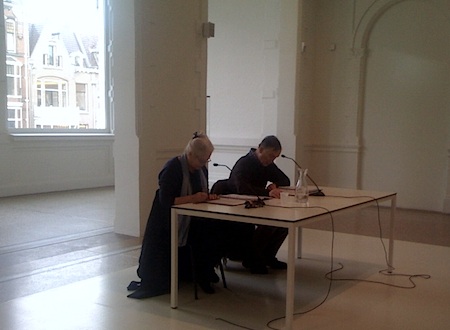
[880503959851008] Mapmyfollowers is a simple web application that combines the Twitter API with Google Maps, to provide a map view of the set of users that follow a given twitter account. The picture below thus gives a map view of the modest ensemble of Soundblog Tweets followers. Also the wordcloud of 'Common Follower Terms' is interesting. It probably is obtained from the words and terms used in the followers' bios, accessible in their Twitter profile. (Click the image for a larger view).
- Nov 06, [9317639285374976]
On reconstruction of the first ever recorded sounds (¿!Text ends w/ pretty
curious recording!¿)>
http://j.mp/frstsnd (cf. http://j.mp/cllun)
[[Oude Pijp, Amsterdam]] - Nov 15, [4034567753170944]
"I found that there was no source of realistic ears available" - Building
a Binaural Dummy Head > http://j.mp/dmmrs
(@timprebble, @Plague88)
[[Oude Pijp, Amsterdam]] - Nov 19, [5504881003601920]
"Football Sound Narratives" A compilation curated by Rui Costa & Duncan
Whitley > [ http://j.mp/nodar001
] (cf. SB http://j.mp/zidap)
[[Vincennes, Paris]]
Over the past years 10, 12 years I made quite a few (sound- but also other)
things that are quite directly related to football (soccer). These always
came about in the general - social - excitement surrounding a major European
or world tournament. Even though I
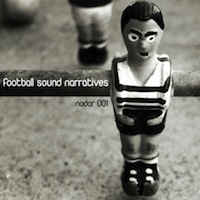 always almost boast that
I am hardly interested in these events, the 'body of work' that they inspired
do seem to indicate quite the contrary.
Indeed, my works may know me better that I do know myself... The
bulk of the material used for the two short but mighty fine final tracks of the Sound
Chronicles - LeFootball (available as a free
download at Bandcamp's) and SportNational
- was dictaphoned in the wake of the French national team's 1998 world championship.
Then this year's world cup tournament was such that I simply could not but
do as I did: produce the breath taking and majestic Final
Soundtrack...
always almost boast that
I am hardly interested in these events, the 'body of work' that they inspired
do seem to indicate quite the contrary.
Indeed, my works may know me better that I do know myself... The
bulk of the material used for the two short but mighty fine final tracks of the Sound
Chronicles - LeFootball (available as a free
download at Bandcamp's) and SportNational
- was dictaphoned in the wake of the French national team's 1998 world championship.
Then this year's world cup tournament was such that I simply could not but
do as I did: produce the breath taking and majestic Final
Soundtrack...
And then four years ago, in 2006, with Ana_R we organized an impromptu placard
at my place in order to provide an alternative
live soundtrack to that year's final. The piece that afterwards I composed
from the recordings of that evening ("Le Zida ne passera pas par moi")
is one among 11 fascinating "football sound narratives", curated by Rui
Costa and Duncan Witley, now available as a free net CD by the Portuguese
Binaural. Go
get it!
4'33" = 3 x 1'31"
- Nov 19, [5757987150897152]
If someone's eager to do 563 pages cult hist monograph: dissect this uTube
+ comments > [ http://j.mp/cg433orch
] (via @timprebble, @kottke)
[[Vincennes, Paris]]
[14773129683402752],
[14773680429080577],
[14785327570886657],
[15306429334290432],
[15736407653879808],
[15780080353542144]
To use an easy pun: there are but few works of 20th century art that have
caused as much noise as Cage's infamous 'silent' piece of music. The composer
himself, during his lifetime, always kept relatively quiet about the work,
as James Pritchett points out in What
Silence taught John Cage: The Story of 4'33', his contribution to the
catalogue of the 'Anarchy
of Silence' exhibition. ( * )
4'33" is the ultimate example of a composition that came about by sheer
historical necessity. In view of the development of western art
in the 20th century 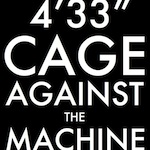 it was unavoidable that eventually someone would - have
to - write a silent - no intentional sound - musical composition.
History choose John Cage to do this. He gave it a certain form, made it last a certain amount of time and called
it 4'33".
it was unavoidable that eventually someone would - have
to - write a silent - no intentional sound - musical composition.
History choose John Cage to do this. He gave it a certain form, made it last a certain amount of time and called
it 4'33".
Much of the recent hype around the piece was caused by Cage
Against The Machine, an attempt to get a recording of 4'33" at number #1 of the British pop charts for Christmas. Interesting
first of all that such an idea arises. It does - once again - say a lot about how, over the past sixty years, the ideas and
enterprises of a once elitist, small and
relatively obscure avantgarde, sixty years later have managed to become, in some form or other, part of everyday cultural consciousness.
Many people like 4'33", be it often for reasons quite unrelated to those that originally motivated it. Which then in turn may have
some of us grumble that 'one' doesn't understand the piece. But whether you take it to the left, or take it to the right: this is the way
in which ideas spread, and things once near to unthinkable become 'commonplace'.
Of course I bought the track, for the mere idea that four and
a half minutes of 'nothing' might be made into a Christmas hit,
was too good to just let pass. It didn't work out, though the collectively raised
enthusiasm did manage to get the track into the Top 40. By the way, the full
Cage Against The Machine album, which besides the 'hit track'
contains 7 'remixes', is a surprisingly good listen. A fun sound document that I full
heartedly recommend.
The attempt did attract quite a bit of media attention. It thus could happen that Dutch contemporary music champion and pianist Reinbert De Leeuw was invited to perform the full 4'33" at the December 13th emission of the Dutch prime time television program De Wereld Draait Door. In the picture below you can see that as his score Reinbert used the facsimile contained in the catalogue of the 'Anarchy of Silence' exhibition.
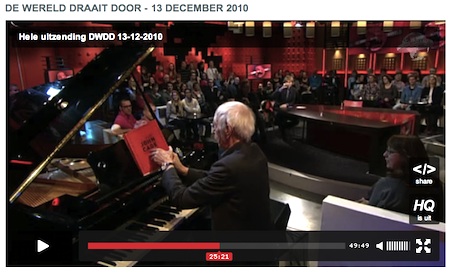
- Nov 23, [6971381157724160] "Schönste Schlaufen" Kind write-up on my passage @shiftfestival by miss.gunst http://j.mp/schsch & perf rev. :http//j.mp/shftcnc (in German)
- Dec 01, [9896296479457280]
"La récup, un art majuscule à Shift" Marie Lechner on found
tapes & the @shiftfestival
in Libération (in French) > [ http://j.mp/libshft
]
[[Oude Pijp, Amsterdam]] - Nov 25, [7721595434958848]
Smail => Stijn Demeulenaere your personal, handwritten, sound memories
for inclusion in his ongoing work 'Soundtracks' http://j.mp/dF4nhT
[[Oude Pijp, Amsterdam]]
Soundtracks is a silent soundart piece by the Belgian artist Stijn Demeulenaere. Stijn collects handwritten recollections of sounds. Sound memories. These written memories of sound he puts into glass jars. He exposes them in quiet rooms, that people can visit. There they can open the jars, take out the little pieces of paper, and read others' memories of sound... The work is ongoing. Do send your contributions to Stijn!
- Dec
05, [11484283159969792]
Yesterday La Comète 347 was destroyed by fire. No one got hurt,
but this is an awful loss for independent art in Paris > http://j.mp/gJUat8
[[Maastricht, Limburg]] - Dec 07, [12047644016779264]
Andrew McNiven made recording by placing microphone in the front right-hand
drawer of Sigmund Freud's desk @Noble_Sounds
http://j.mp/frddsk
[[Maastricht, Limburg]] - Dec 19, [16449293145608192]
"Sound art' doesn't really exist", argues Jonathan Jones in his Guardian
blog < [ http://j.mp/nosoart
] (via @Kunstbeeld)
[[Vincennes, Paris]] - Dec 20, [16797685612814339]
@barbquiek 0°C à Paris, snow falls, snow melts, white up, brown down,
the passing of traffic sounds like liposuction ... #eartwit
[[Vincennes, Paris]]
- Dec 21, [17176590731452416]
1. Paris Side: RT @preslav "Gare du Nord. Queue snakes thru entire building & full length of outside platform. Moving slowly & calmly."
[[Vincennes, Paris]] - Dec 21, [17176699493949440]
2. London Side: RT @flaneur "Just passed Eurostar queue, people stood down Euston Rd all way to British Library & further. Unbelievable. :("
[[Vincennes, Paris]]
This is a nice example, I'd say, of the force of Twitter, showing you two different sides of the same 'case', instantaneously.
- Dec
22, [17667209715257344]
RT @barbquiek The Young Lions;
garage-sound "proberaum"-feeling really do love it ... > [ http://j.mp/bcylttb
]
[[Vincennes, Paris]] - Dec 30, [20586390081245184]
Kasper Sloot - "Study of Frank Zappa's Musical Language (with many note
examples and midi files)" > [ http://www.zappa-analysis.com/
]
[[Oude Pijp, Amsterdam]] - ...
- Dec 18, [16130582933147650]
Thanks for the music, Captain! RIP Don Van Vliet (Jan. 15, 1941 – Dec.
17, 2010) > http://j.mp/nytdvv
- Listen now: http://bit.ly/22orig
[[Vincennes, Paris]] - ...
...
More SB Tweet Digest in February.
Probably.
Meanwhile ! Follow @soundblog
_( ![]() )_ resonancenet@ wolloF
!
)_ resonancenet@ wolloF
!
...
notes __ ::
(*) For the Dutch installment of the exhibition, in
Schunck in Heerlen, the catalogue was translated into Dutch. I ended up with a Dutch
copy, because there were no more English ones available. According to the
liner notes, the translation was done by the Dutch bureau ISA
Vertaal. For the record: this is one of the worst English to Dutch translations that I have
ever come across. The original articles were given a 'Dutch' version that doesn't cease to make
my toes curl. Here's the Dutch word for the job that ISA Vertaal did on the Cage catalogue:
wanprestatie. [ ^ ]
tags: tweet, digest
# .400.
comments for Happy New Prime Year! ::
|
Comments are disabled |
